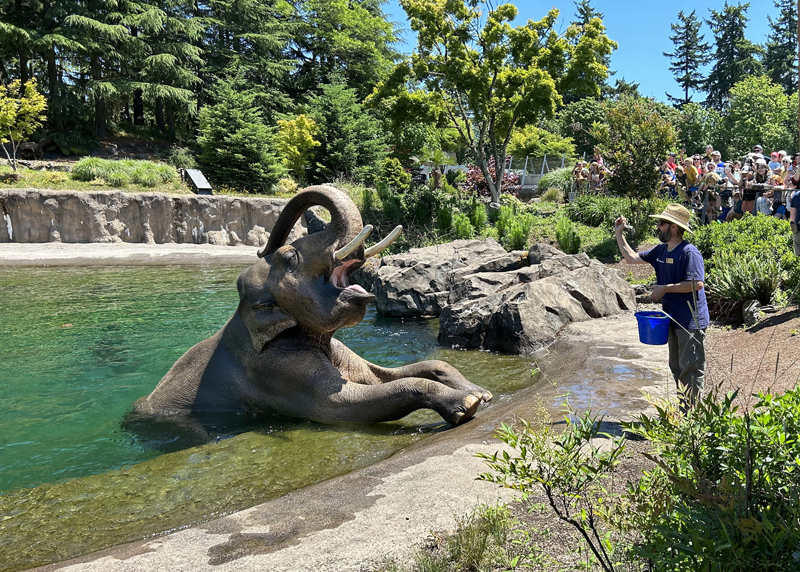INSIDE:
NEWS/STORIES/ARTICLES
Book Reviews
Columns/Opinion/Cartoon
Films
International
National
NW/Local
Recipes
Special A.C.E. Stories
Sports
Online Paper (PDF)
CLASSIFIED SECTION
Bids & Public Notices
NW Job Market
NW RESOURCE GUIDE
Consulates
Organizations
Scholarships
Special Sections
Asian Reporter Info
Contact Us
Subscription Info. & Back
Issues
FOLLOW US
Facebook
ASIA LINKS
Currency Exchange
Time Zones
More Asian Links
Copyright © 1990 - 2024
AR Home

Where EAST meets the Northwest
|
SPECIES SURVIVAL PLAN. Raja the elephant (top photo, courtesy of the St. Louis Zoo) has been one of the biggest attractions — literally and figuratively — at the St. Louis Zoo for decades. Now, he’s moving away. The zoo announced that the male Asian elephant born at the zoo nearly 31 years ago will be relocated to the Columbus Zoo and Aquarium in Ohio, probably in about a year. When Raja leaves, the St. Louis Zoo will have room for a new male. The zoo said that male is tentatively expected to be a 15-year-old named Samudra (bottom photo, AR photo by Jan Landis) from the Oregon Zoo in Portland. From The Asian Reporter, V34, #01 (January 1, 2024), page 11. Raja the elephant, a big draw at the St. Louis Zoo, is moving to the Columbus Zoo and Aquarium to breed By Jim Salter The Associated Press ST. LOUIS — Raja the elephant has been one of the biggest attractions — literally and figuratively — at the St. Louis Zoo for decades. Now, he’s moving away. The zoo announced that the male Asian elephant born at the zoo nearly 31 years ago will be relocated to the Columbus Zoo and Aquarium in Ohio, probably in about a year. The hope is that he’ll bond with four females in Columbus, breed, and mentor a young male there. Raja was the first elephant ever born at the St. Louis Zoo, and the 10,000-pound animal’s birthday on December 27 has always been a big deal each year, complete with treats, songs, and lots of visitors signing an oversized birthday card. "This news is bittersweet for all of us," Michael Macek, director of the St. Louis Zoo, said in a statement. "We know Raja is dear to his fans and to the zoo family and he’ll be missed here, but we know this is for the best for Raja and the survival of this species." Asian elephants are endangered, with fewer than 50,000 in the wild, according to the World Wildlife Fund. Habitat loss and poaching are blamed for their plight. They are the largest land mammal on the Asian continent. The Association of Zoos and Aquariums’ Asian Elephant Species Survival Plan recommended the move of Raja, the St. Louis Zoo said. The program seeks to manage the Asian elephant population in North America and maximize the health, wellbeing, and genetic diversity of the elephants, the zoo said. Raja is the father of the only three female Asian elephants of breeding age in St. Louis. The other three females there are too old to reproduce, and one of them is Raja’s mother. In October, Rani, a 27-year-old female Asian elephant, died after becoming agitated when a small loose dog managed to get into the zoo and upset the herd. Macek said the move of Raja mirrors the natural behavior of wild elephants. While females raise the calves and live in multi-generational family groups, males live alone or in small bachelor herds. They breed, then move on, Macek said. "Raja moving to Columbus provides an environment where he and others can naturally grow their families, which is an important component to their wellbeing," Macek said. The move is expected to occur in late 2024 or early 2025. When Raja leaves, the St. Louis Zoo will have room for a new male. The zoo said that male is tentatively expected to be a 15-year-old named Samudra from the Oregon Zoo in Portland. Samudra was born at the Oregon Zoo on August 23, 2008, weighing in at 286 pounds. He was the first third-generation elephant born in the United States. Samudra has always loved the water — his name means "ocean" in Sanskrit. The roughly 10,000-pound pachyderm is often seen playfully splashing in the 160,000-gallon pool at the zoo’s Elephant Lands exhibit. His care team expects him to put on another ton or two over the next couple of decades. Meanwhile, Raja’s 16-year-old daughter Jade is pregnant with her first calf and due to give birth at around the time that Raja leaves — Asian elephants are typically pregnant for up to 22 months. It will be the first elephant calf born at the zoo through artificial insemination. The father is housed at the Denver Zoo. Read the current issue of The Asian Reporter in
its entirety!
|


